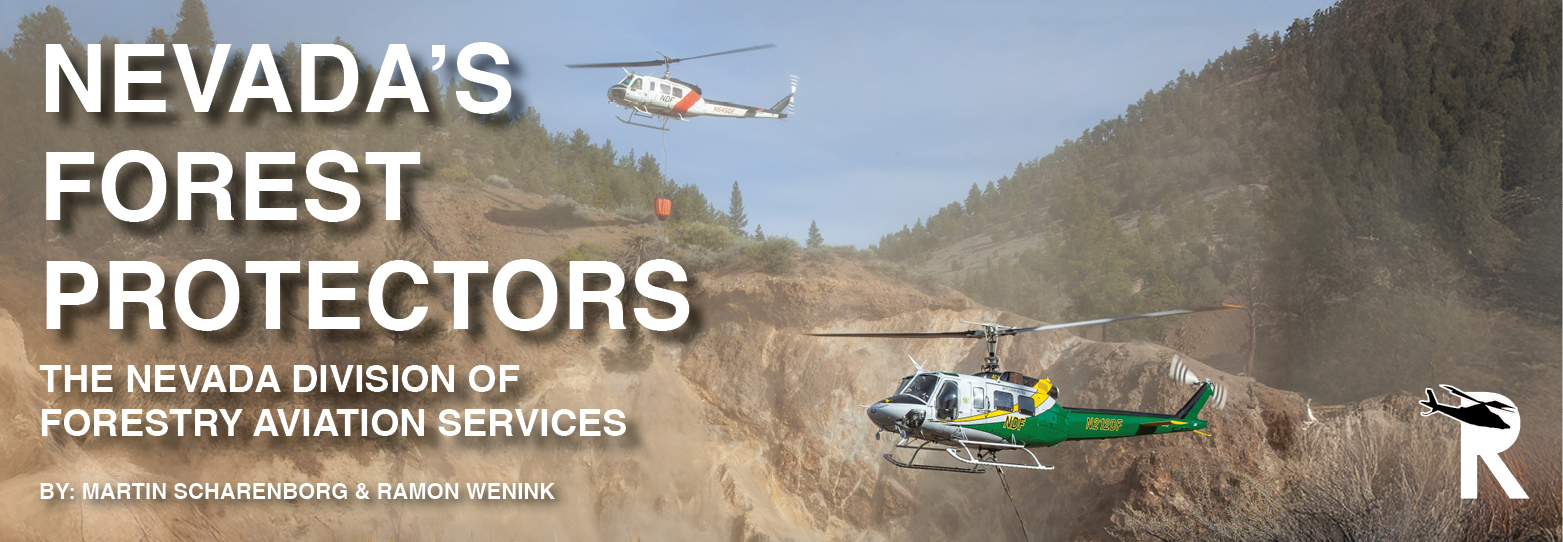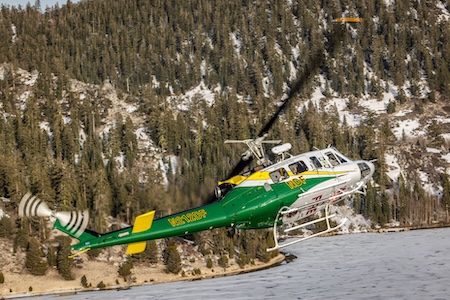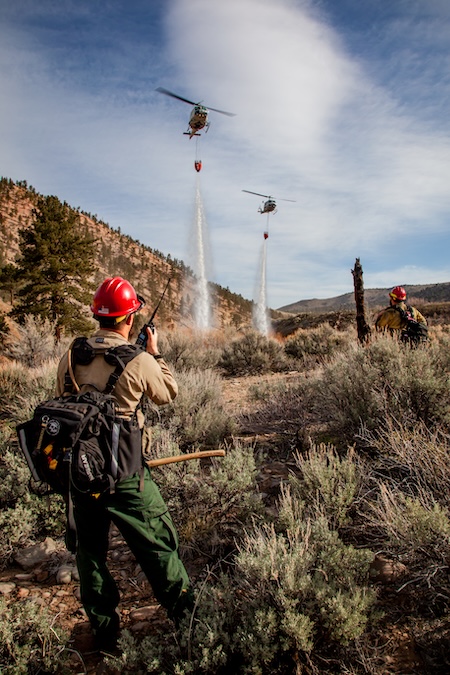|
Jun
16
2025
|
|
Posted 174 days ago ago by Admin
|
|

Having responded last year to 263 wildfires that burned over 134,000 acres, the Nevada Division of Forestry relies heavily on its fleet of helicopters. Martin Scharenborg & Ramon Wenink visited and flew with the Nevada Division of Forestry Air Operations to learn about their mission and the challenges they are facing.
With thousands of wildfires nationwide occurring annually, the use of airborne assets prove to be of great value in fighting these fires. Therefore the Nevada Division of Forestry (NDF), founded in 1957, started its own aviation program in 1959 by converting a Beechcraft C-45 Torpedo bomber into an air tanker for firefighting. It took another 15 years when the first helicopters were acquired with assistance of the U.S. Forest Service. Three Bell TH-13Ts from surplus U.S. Army stocks entered service in 1974 primarily for aerial fire reconnaissance. Although there was a strong need for a strong and capable firefighting helicopter , the three Sioux helicopters soldiered on and remained in service until 1991. In 1993 the U.S. Forest Service assisted again in acquiring surplus Army helicopters for the NDF. The Bell UH-1H Huey was selected because of its powerful engine and the ability to transport a considerable number of firefighters in the back of the aircraft. Eventually three UH-1Hs entered service from 1994 and that year is seen as the birth of the current NDF’s ‘Battle Born Helitack Program.’ From 2006, the fleet of UH-1H helicopters received several upgrades to meet present and future requirements. In 2019 one UH-1H was retired and replaced by an Eagle Copters ‘Eagle Single,’ a Bell 212 conversion.

Mission
The official mission of the NDF is to conserve Nevada’s natural resources and communities by wildfire management and natural resource stewardship on public and private lands. NDF’s aviation services area of responsibility is therefore the whole state of Nevada, which goes from the eastern front of the Sierra Nevada mountains that extends from Mammoth Lakes, California, up to Susanville, California, to as far south as the Las Vegas area. There is always at least one helicopter on 10 minutes standby, 24/7 all year long.
The NDF’s aviation services operate out of Minden-Tahoe Airport, south of Carson City in western Nevada. Currently the NDF has four full-time pilots, one ‘Helitack’ supervisor (the helicopter manager) and three full-time assistants. When the annual fire season in Nevada starts, normally June 1 through September, this is added annually by approximately 22 seasonal Helitack firefighter crews. These crews are transported by helicopter to a wildfire to build firelines, and prepare, if necessary, better helicopter landing areas to deliver fire-fighting supplies. These 22 crews also include two to four helicopter manager trainees. The daily crew normally consists of one pilot, a Helitack manager, and around six Helitack firefighters, but may vary depending on the nature of the mission.

Super Hueys
The backbone of the fleet are two UH-1H Hueys that have been drastically modified since 2006 to meet stringent requirements. The original Lycoming T53-L-13B (1,400 hp) turboshaft engines were replaced by the more powerful Lycoming T53-L-703 (1,800 hp) turboshaft engine that is also used in the Bell AH-1 Cobra Gunship helicopter. Other modifications include BLR Aerospace’s ‘FastFin’ tail rotor enhancement and stability system to provide more stability during hover operations. This, together with tail boom strike kits and new composite main rotor blades, contributed to an impressive improvement of control effectiveness but also fuel efficiency and safety. Other aircraft additions include: GPS, a Garmin moving map system, new gauges, NAT NPX136 and Bendix King radios. Bubble windows also allow a better view for dropping water. The UH-1Hs were affectionately called ‘Super Hueys.’ One UH-1H Huey (403) left NDF service in 2019 to serve as a spare part source and to make way for a new helicopter in the fleet.

Eagle Single
The Eagle Single is a Bell 212 conversion performed by Eagle Copters Ltd. in Calgary, Canada, and was bought in 2019 . Chief Pilot Kris Kirkland, who is basically the chief of NDF aviation operations, said, “It was an interesting Challenge, because two of us were supposed to fly to Calgary to pick it up, but everything got shut down because of COVID and therefore we couldn’t fly commercial. So, in the end they actually trucked the aircraft over here. It is considered to be a factory-new aircraft. We built everything how we wanted it to be in the panel: avionics, communication, navigation, including two different sets of comm/NAV-systems provided by Garmin. With the Eagle Single, we also have the possibility to plug in a hand-held radio and talk through the aircraft system with people on the ground that are communicating on (non- aviation) frequencies. The airframe has 14,000 hours, but everything else is brand-new. It is a great aircraft; we love it. The potential for us to go on high altitudes is there, but we have to go through thorough planning when having people on board. Limitations might occur from 25 degrees Celsius. Our direct area of operations has mountains up to 15,000 feet. We tackle that by taking some fuel off in order to accommodate more people, or arranging support by fuel trucks enroute to the area of operation.”
Impressive performance
Kirkland also praises the Eagle Single’s hauling performance, “External load wise, it is fabulous. The standard bucket configuration between the two aircraft is that the Eagle Single normally carries the 324-gallon Bambi Bucket, while the UH-1H Huey takes the 240-gallon Bambi Bucket. The Eagle Single can carry both buckets, but the Huey will only take the 240-gallon bucket as they are not wired for SEI Industries’ Bambi-Max. This bucket has a modulating valve that can only be operated out of the Eagle Single and it is such a great tool. You can do a split drop or a line drop. Our buckets have pumps to draw water from low water level basins or rivers. This is necessary as we have limited water resources in Nevada, especially in the dry season.”

Kirkland continues, “I do like the capabilities of the Eagle Single with the tail rotor. It is still a 212, but it is a single-engine 212, so it has bigger composite rotor blades. It has a bigger tail rotor, and a push-pull tube instead of cables for tail-rotor control. It has a tractor tail rotor, so the tail rotor on the Eagle Single is on the right side while the Huey has it on the left. I have stuck that tail in some pretty high winds and it just performs like a champ. It’s awesome! For that (reason), we would love to buy more Eagle Singles but we are limited by the passengers and ‘weight/temperature chart’ for carrying passengers as it is a certificated FAA aircraft. The Hueys are not limited by the weight/altitude chart for carrying passengers.”
Hoisting
Hoisting is very important in the range of duties for the Helitack crew. To allow firefighters to get as close as possible to the fire, or even to extract them if a normal pick up or egress over land isn’t possible, hoisting can be a game changer. Another task of the NDF aviation service is search and rescue (SAR). When people are trapped due to wildfires or when accidents happen in the rugged Sierra Nevada mountain range, hoisting is essential. The Eagle Single has a Goodrich external hoist that can carry 600 pounds. The Hueys have an internal Goodrich hoist that is also capable of lifting 600 pounds. Because of weight and center of gravity, the hoist on the Eagle is on the right side of the aircraft and the hoist on the Huey’s is placed at the left side.

“The only tradeoff with the Huey is that the entire hoist is one package. The internal hoist weighs 168 pounds, so we have pretty good weight savings when we pull that hoist out. With the Eagle Single, all the integrated parts: the cables, the wiring, the hardpoints, remain on the aircraft. If we take that hoist off it would only save us 68 pounds. So most of the time we leave it on the aircraft. From my point of view our hoist program is a very professional program,” Kirkland says. “Our pilots are top notch and our crew members have really picked it up well. The pilots that come here have done some sort of hoisting in the past. We had a company come in for a one week course of hoist training and all of the crews picked it up very fast. There are, of course, other agencies called to help out when people get hurt. My intention was, when I came into this position, to get us more visibility with all of our local co-operators and say ‘OK, Reno-Fire, Lion County Fire, Story County Fire , East Fork County Fire Protection, Tahoe Fire Protection District, you know who we are: The Nevada Division of Forestry, but we have this capability of hoist.’ In conjunction with that, what I am charged with, is establishing contacts within these agencies to start conducting training events with them. That gives us exposure as well as it gets them trained on how we do our operations. They as well see we are professional. I think we are well on the way to prove to the community and the other operators that we have a quality hoist program.”
Mission Variety
Thousands of acres of land are annually destroyed or damaged by wildfires. One of the NDF’s tasks is to reseed these damaged lands with drought resilient grasses, wildflowers and shrubs. For that, the helicopters of NDF Air Operations are indispensable. Kirkland said, “The unique thing with our helicopters is that we can carry two seed buckets. We dispersed almost 9,000 acres with seeds in the aftermath of the Tamarack fire in 2021 in just a week and a half. That is the biggest project that we have done so far. But that is not all that we do. The Division of Mines asked the NDF to look for un-surveyed and unsecured mines and holes . We are helping them to find these sites so they can place fences and signs to prevent people from falling into them. We also have an agreement with the Nevada Department Of Wildlife (NDOW) . We help them out by doing surveys using their aircraft (the Eagle Copters 407HP) to count elk, sheep, deer and other animals. We also filled our Bambi buckets with wildlife water guzzlers to provide wildlife with water during dry seasons. Now, (NDOW) can do that themselves with their powerful 407HP. Furthermore, we participate in prevention events where we display our aircraft and explain our tasks.”

Challenges
Kirkland expounds on the challenges of flying for NDF Air Operations: “It starts with the basic experience that goes from pilots to the ground crews. Being able to understand fire behavior, being able to understand meteorological conditions and where you are, how you are performing, how the aircraft is performing. There are changing conditions all the time. Wind conditions change as the fire affects the wind. Being able to read those conditions and what the crew on the ground needs and how to support them are some of the biggest challenges. Let’s not forget the long duty times! Fire season starts normally on the 1st of June. From then until about October 1, we operate 24/7. We man two aircraft during that time for seven days a week. That means the helicopters operate during daytime. but the crew on the hill will work all night long.”
Future
Having been in service for many decades, the end is drawing near for the venerable UH-1H as spare parts are increasingly difficult to obtain and airframes are entering the end of their lifespan. Kirkland said, “Our intention initially was to outfit the fleet for consistency and commonality with the Eagle Single, but now I think our intent is to replace the legacy Huey’s with the Bell 205A1 ++ aircraft. We did get a quote from Eagle Copters Ltd. last year for a 205A1 ++, which is really no different, other than that the 205 was built as a single-engine helicopter. But there are also different charts built for the 205A1++ versus the charts that had been built for the Eagle Single, so for us the 205A1++ will perform better than the Eagle Single. We also considered acquiring the Leonardo AW139, but it was $12 million, while the 205A1++ was only $4.5 million. Also the AW139 is a four-bladed helicopter and that wouldn’t fit in the present hangar if we aim for maintaining four aircraft. Two aircraft would have to sit outside.”
Another one of Kirkland’s strategic long-term goals is to initiate a small UAS program to see hotspots, to map seeding plots, and to do prescribed back burns with ethylene glycol balls that the drones can drop. “I think that is the way it will be going more and more,” says Kirkland. “The NDF will probably start implementing this UAS program within the next two years.”
READ MAR/APR ISSUE OF ROTOR PRO
READ MORE ROTOR PRO: https://justhelicopters.com/Magazine
WATCH ROTOR PRO YOUTUBE CHANNEL: https://buff.ly/3Md0T3y
You can also find us on
Instagram - https://www.instagram.com/rotorpro1
Facebook - https://www.facebook.com/rotorpro1
Twitter - https://twitter.com/justhelicopters
LinkedIn - https://www.linkedin.com/company/rotorpro1